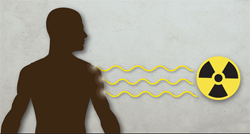Key points
- Electromagnetic radiation is energy that comes from a source and travels through space at the speed of light.
- Electromagnetic radiation has an electric field and a magnetic field associated with it and has wave-like properties.
- You could also call electromagnetic radiation “electromagnetic waves."

What it is

Radiation with the highest energy includes forms like far ultraviolet radiation, x-rays, and gamma rays. X-rays and gamma rays have a lot of energy. When they interact with atoms, they can remove electrons and cause the atom to become ionized.
Categories
The radioactive atom
- Radioactive atoms have unstable blends of protons and neutrons.
- Radioactivity is the spontaneous release of energy from an unstable atom to get to a more stable state.
- Ionizing radiation is the energy that comes out of a radioactive atom.
- Radioactive isotopes are radioactive atoms of the same element that have different numbers of neutrons.
Properties of radioactive isotopes
- Radioactive atoms can give off four types of ionizing radiation: alpha particles, beta particles, gamma rays, and neutrons.
- Each type of radiation has different properties. Their properties affect how we can detect it and how it can affect us.
- An unstable atom changes into a more stable atom of the same or different element by giving off radiation. This process is called radioactive decay.
- A half-life is the length of time it takes for half of the radioactive atoms in a group of radioactive isotopes to decay.
Preventing exposure
The guiding principle of radiation safety is "ALARA." ALARA stands for "as low as reasonably achievable."
ALARA means avoiding exposure to radiation that does not have a direct benefit to you, even if the dose is small. To do this, you can use three basic protective measures in radiation safety: time, distance, and shielding.
